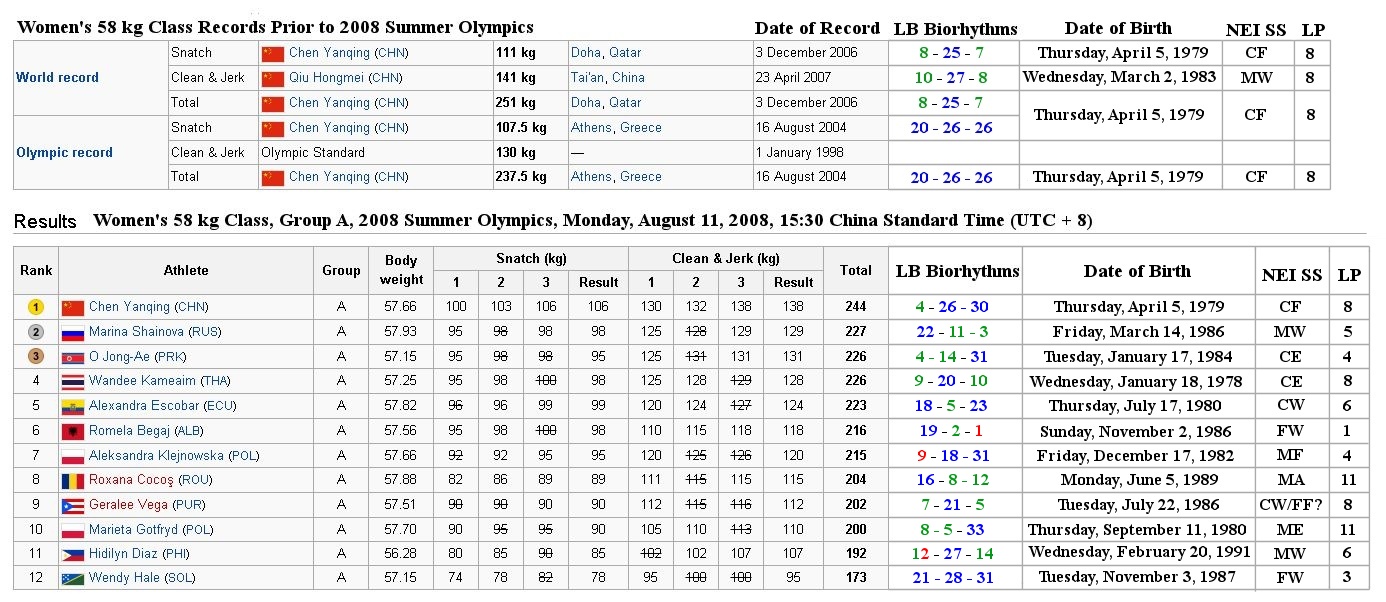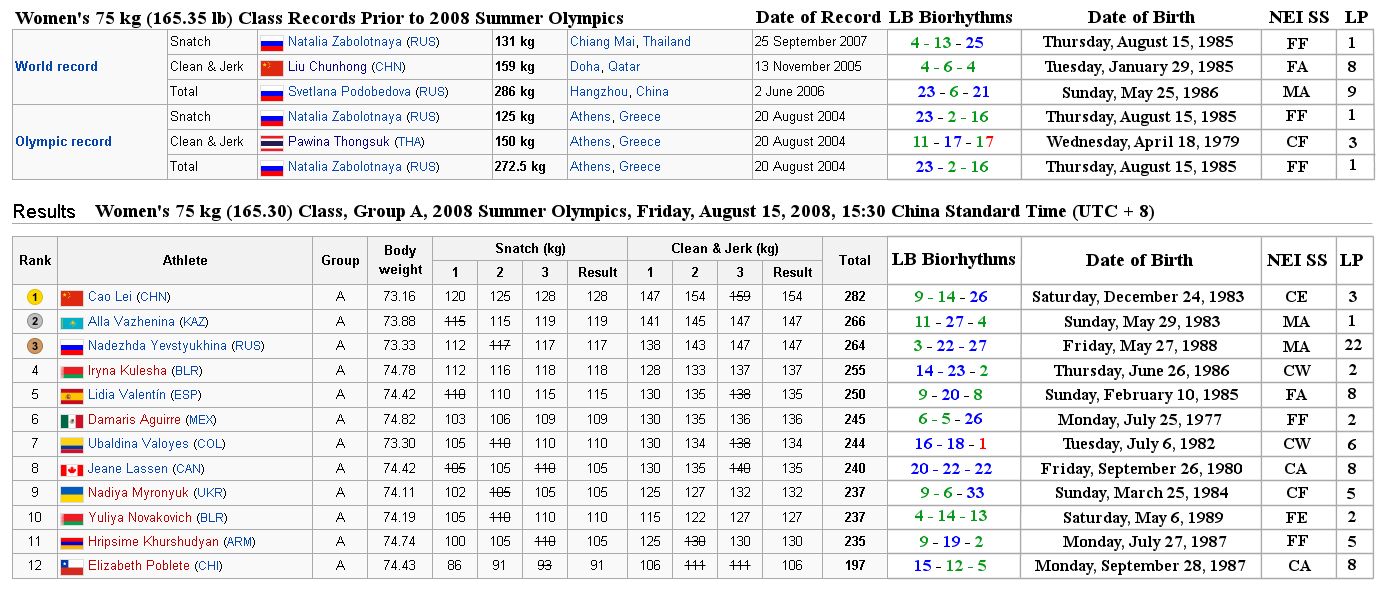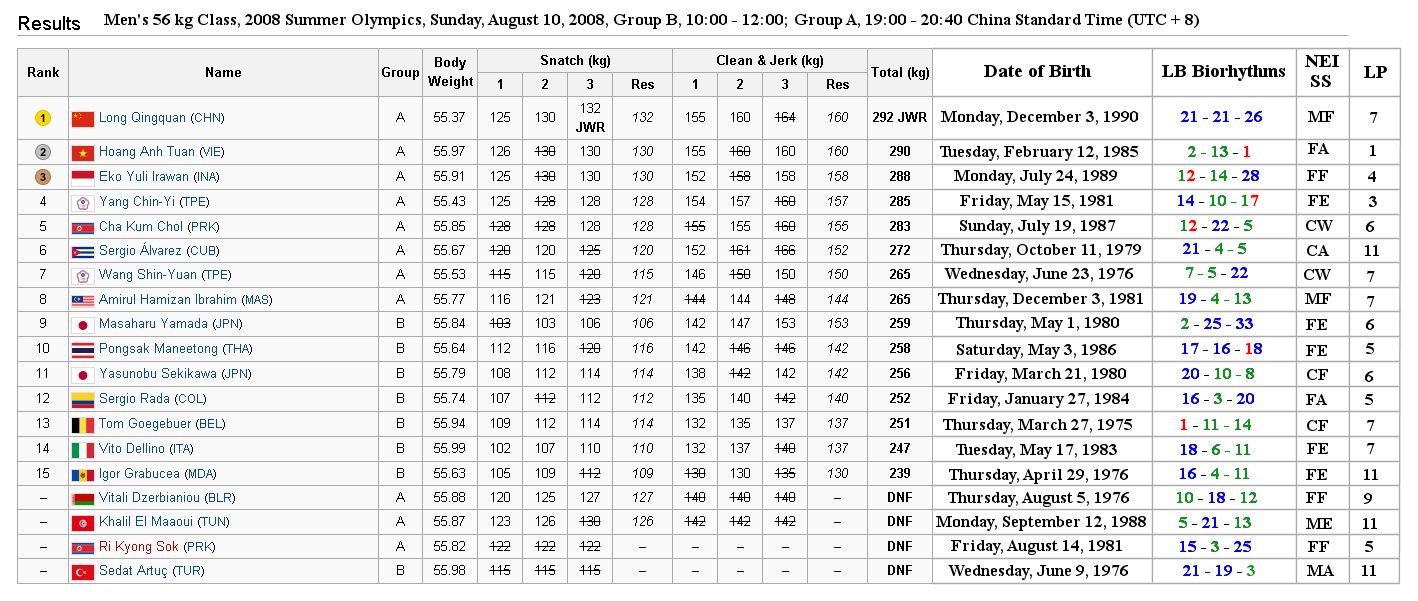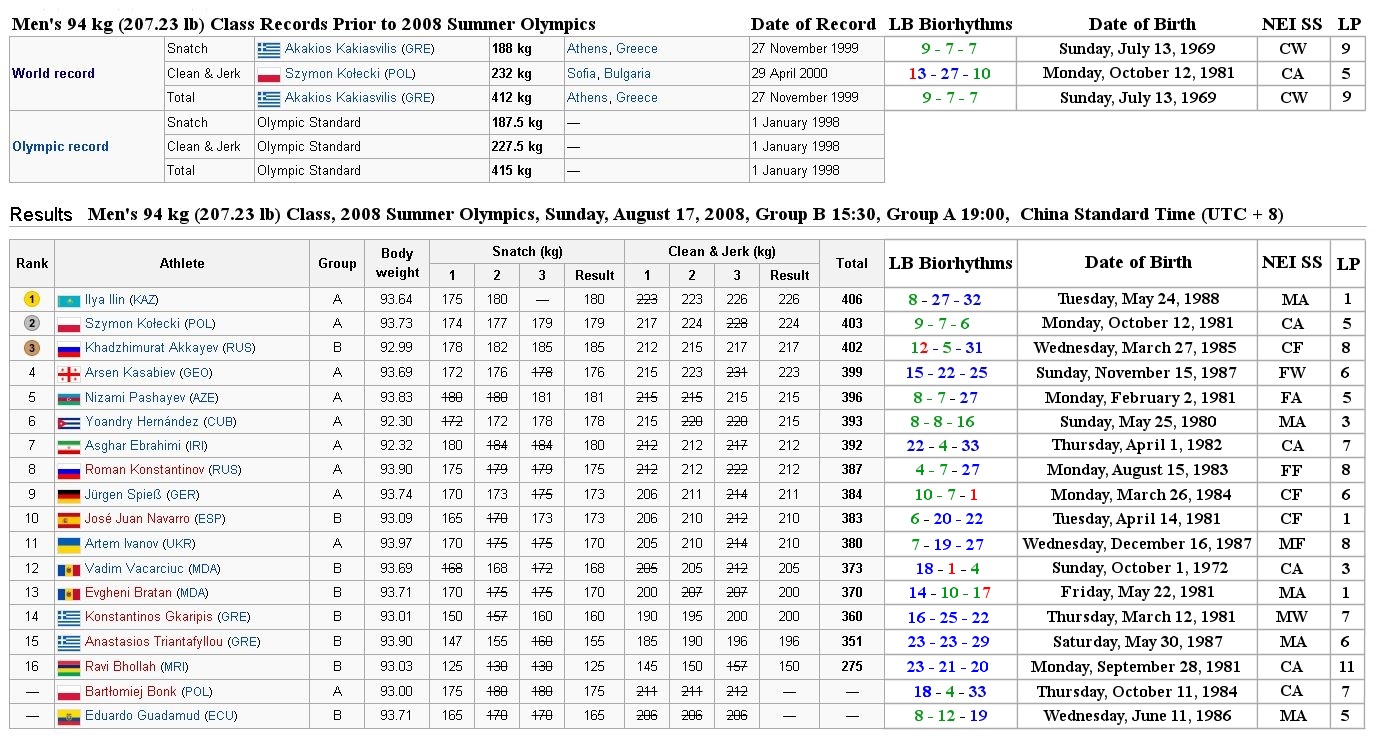Columbus (Ohio) Weightlifting has individual videos posted of those who competed in the recent Arnold Weightlifting Championships from March 1 - March 3, 2013, in Columbus, Ohio. You can see a unique back flip celebration of a successful 105 Kg C & J by Maegan Snodgrass (Women's 69 Kg class) here, and here, and then explore the other available videos from there. Add note Wednesday, March 6, 2013
QuickLinks to 2008 Olympic Lifting Results Showing Biorhythms of Each Lifter 2012 London Summer Olympics Weightlifting Results
This page is dedicated to the exploration of the connection, if any, between performance in Olympic Weightlifting competition and the status of the lifter's left-brain biorhythms on the day of competition. For an overview and introduction to the subject of biorhythms, please go to here and here (At the bottom of this second item you will see a note explaining how to obtain either a single-page sample chart or a full-year multi-page chart showing all 7 cycles, 3 left-brain cycles & 4 right-brain cycles). And you can find links to additional information of possible interest concerning weightlifting and biorhythms here. You can see an especially pertinent and detailed article about applying knowledge of biorhythms to weightlifting training here.
In the charts that follow, only the status of the 3 left-brain biorhythm cycles will be given. Specifically, the Physical, Emotional, and Intellectual cycles. The status of those cycles will be indicated by 3 hyphenated numbers, such as 6-17-10. The first number represents the status of the Physical cycle, the second number represents the status of the Emotional cycle, and the third number represents the status of the Intellectual cycle.
Since the Physical cycle is 23 days long, each half of that cycle is 11.5 days long. The number in the first, up portion that indicates the day of greatest theoretical Physical strength, is 6, with very close to the greatest theoretical Physical strength being indicated by 5 and 7. Any number between 2 and 11 indicates a time of generally greater Physical strength. On the other hand, the number in the second, down portion that indicates the day of weakest theoretical Physical strength, is 18, with very close to the weakest Physical strength being indicated by 17 and 19. The two "critical" days of the Physical cycle are indicated by 1 and 12.5. You'll especially want to check to see what day in their Physical cycles the competition winners as well as those who set world records were at. I think you'll find the results to be particularly interesting.
Since the Emotional cycle is 28 days long, each half of that cycle is 14 days long. The number in the first, up portion that indicates the day of greatest theoretical Emotional optimism, is 7, with very close to the greatest theoretical Emotional optimism being indicated by 6 and 8. Any number between 2 and 14 indicates a time of a generally optimistic Emotional frame of mind. On the other hand, the number in the second, down portion that indicates the day of the theoretically least optimistic Emotional nature is 21, with very close to the least optimistic Emotional nature being indicated by 20 and 22. The two "critical" days of the Emotional cycle are indicated by 1 and 15. You'll especially want to check to see what day in their Emotional cycles the competition winners as well as those who set world records were at. It will especially interesting to learn which lifters had both their Physical and Emotional cycles at or near the peak of those up cycles.
Since the Intellectual cycle is 33 days long, each half of that cycle is 16.5 days long. The number in the first, up portion that indicates the day of greatest theoretical Intellectual ability, is 8, with very close to the greatest theoretical Intellectual ability being indicated by 7 and 9. Any number between 2 and 16 indicates a time of a generally greater Intellectual ability. On the other hand, then number in the second, down portion of the cycle that indicates the day of the theoretically least Intellectual ability is 24, with very close to the least Intellectual ability being indicated by 23 and 25. The two "critical days of the Intellectual cycle are indicated by 1 and 17.5. And it will also be interesting to see which lifters had their Intellectual cycles at or near the peak of the up cycle.For a fuller explanation of a "critical day", check this out. And you'll find two excellent examples of how "critical days" adversely affected the lifting performances of two Group A lifters in the Men's 77 kg Class. So adversely, that they failed to total! While there's a "learning curve" involved in understanding the effect of biorhythms on your life, just as there is with anything that is new to us, if such knowledge & understanding keeps you from either failing to total or underperforming in competition or training, don't you think the effort to understand would be well worth it? And if it helped you to avoid injury or failing to total even one time, how glad would you be to have made the effort to gain such understanding? Go here to see a fuller commentary about those two Group A lifters.
To make it easier to spot the possible effects of biorhythms on a lifter's performance the numbers that show what day a cycle is in are color coded. "Critical" days are shown in red on the charts. Days when a cycle is in the "up" phase are shown in green. Days when a cycle is in the "down" phase are shown in blue. You can save any of the charts to your computer by placing your cursor over a chart of interest, right-click to see a drop-down menu, then left-click on the "Save image as..." option.
In addition, each lifter's Natal Energy Imprint Sun Sign (NEI SS) will be listed for general reference. The first letter indicators are: C = Cardinal, F = Fixed, M = Mutable. The second letter indicators are: F = Fire, E = Earth, A = Air, W = Water.
And since the date of birth also reveals the theoretically chosen "life path" of a person, that information is also given. You can see what that number represents here and here, as well as investigate various other sources of explanation of the "life path" here.
We'll begin with a review of World & Olympic records as established prior to the 2008 Olympics. The second chart for each weight category will provide biorhythm information for the actual day of Olympic competition. Dates of birth will be shown for verification purposes. The charts are from the Wikipedia site to which I have added the dates of birth, biorhythm & natal energy imprint information.
Note: If you would like to see a similar analysis made for a different competition, please email me a link to similar results charts and I'll try to do such analysis as soon as possible. Be sure that such charts show the lifter's dates of birth & date(s) of competition or else include those dates of birth & competition in your email.
2008 Summer Olympics Weightlifting Competition
QuickLinks:Women: 48 kg (105.82 lb) 53 kg (116.84 lb) 58 kg (127.87 lb) 63 kg (138.89 lb) 69 kg (152.12 lb) 75 kg (165.35 lb) +75 kg (+165.35 lb)
Men: 56 kg (123.46 lb) 62 kg (136.69 lb) 69 kg (152.12 lb) 77 kg (169.76 lb) 85 kg (187.39 lb) 94 kg (207.23 lb) 105 kg (231.49 lb) +105 kg (+231.49 lb)
2012 Summer Olympics Weightlifting Schedule: All Classes
Women's 48 kg (105.82 lb) Class Back to QuickLinks


Note: At the 2012 London Olympics on Saturday, July 28, 2012, defending 2008 gold medalist Chen Xiexia's biorhythms will be at 8 - 15 - 4.
Note: A little over a year prior to the 2008 Olympics, the 2008 Olympic gold medal winner of this Women's 48 kg (105.82 lb) Class, Chen Xiexia, had set the World Record in the Clean & Jerk by lifting 120 kg (264.55 lb), approx. 2.5 times her bodyweight. You can see a 23 second long video of that World Record on YouTube.
Women's 53 kg (116.84 lb) Class Back to QuickLinks


Note: At the 2012 London Olympics on Sunday, July 29, 2012, defending 2008 gold medalist Prapawadee Jaroenrattanatarakoon's biorhythms will be at 8 - 13 - 26.
Note: A little over a year prior to the 2008 Olympics, the world record Clean & Jerk for the Women's 53 kg (116.84 lb) Class was set by Li Ping with a lift of 129 kg (284.40 lb), approx. 2.43 times her bodyweight. You can see an interesting 6 min. 57 sec. documentary about Li Ping on YouTube.
Women's 58 kg (127.87 lb) Class Back to QuickLinks
Note: There is an interesting background article on the gold medal winner, Chen Yanqing, here.

Note: At the 2012 London Olympics on Monday, July 30, 2012, defending 2008 gold medalist Chen Yanqing's biorhythms will be at 4 - 19 - 27.
Women's 63 kg (138.89 lb) Class Back to QuickLinks

Note: At the 2012 London Olympics on Tuesday, July 31, 2012, defending 2008 gold medalist Pak Hyon-Suk's biorhythms will be at 15 - 3 - 25.
Important note: The Group A lifter shown in the second line from the bottom of the above chart, Svetlana Tsarukaeva, who failed three times to Snatch 107 kg (235.89 lb) at the 2008 Summer Olympics set a new world's record Snatch of 117 kg (257.94 lb) on Tuesday, November 8, 2011, at the World Championships held in Paris. Be sure to read her comments here. Not surprisingly, her LB Biorhythms were definitely on her side, standing at 3 - 12 - 8.
Women's 69 kg (152.12 lb) Class Back to QuickLinks

Note: At the 2012 London Olympics on Wednesday, August 1, 2012, defending 2008 gold medalist Liu Chunhong's biorhythms will be at 19 - 23 - 15.
Women's 75 kg (165.35 lb) Class Back to QuickLinks

Note: At the 2012 London Olympics on Friday, August 3, 2012, defending 2008 gold medalist Cao Lei's biorhythms will be at 9 - 7 - 23.
Women's +75 kg (+165.35 lb) Class Back to QuickLinks

Note: At the 2012 London Olympics on Sunday, August 5, 2012, defending 2008 gold medalist Jang Mi-Ran's biorhythms will be at 18 - 1 - 2.
Men's 56 kg (123.46 lb) Class Back to QuickLinks


Note: At the 2012 London Olympics on Sunday, July 29, 2012, defending 2008 gold medalist Long Qingquan's biorhythms will be at 21 -14 - 23.
Men's 62 kg (136.69 lb) Class Back to QuickLinks

Note: At the 2012 London Olympics on Monday, July 30, 2012, defending 2008 gold medalist Zhang Xiangxiang's biorhythms will be at 5 - 24 - 15.
Men's 69 kg (152.12 lb) Class Back to QuickLinks

Note: At the 2012 London Olympics on Tuesday, July 31, 2012, defending 2008 gold medalist Liao Hui's biorhythms will be at 5 - 23 - 25.
Men's 77 kg (169.76 lb) Class Back to QuickLinks

Note: At the 2012 London Olympics on Wednesday, August 1, 2012, defending 2008 gold medalist Sa Jae-Hyouk's biorhythms will be at 19 - 23 - 15.
NOTE: To see two excellent examples of how a "critical day" seems to have adversely affected the performances of two Group A lifters to the extent that they both failed to total, take a look at the second & thirds lines from the bottom of the above 77 kg Men's Results chart. Especially significant is the fact that the lifter in the second line from the bottom of the above chart, Taner Sağır, had been the Olympics record holder in the Snatch (172.5 kg)& Total (375 kg)(both set at the 2004 Olympics) prior to the 2008 Olympics, as shown here. The lifter in the third line from the bottom of the above chart, Octavio Mejias, had lifted 152 kg Snatch, and 187.5 kg Clean & Jerk at the 2004 Olympics. Here, 4 years later, he was unable to lift more than the 152 kg Snatch, and failed on all 3 attempts at a 185 kg Clean & Jerk. As I mention here, "critical days" "can basically be thought of as days when we are prone to errors in judgment". Further, "The basic principle to keep in mind regarding a "critical day" is to simply allow more time for consideration of your alternatives before making a decision." Had the two lifters been consciously aware of the need to "allow more time for consideration" of their starting lifts, they might not have left their best lifts in the warmup room. Men's 85 kg (187.39 lb) Class Back to QuickLinks Note: At the 2012 London Olympics on Friday, August 3, 2012, defending 2008 gold medalist Lu Yong's biorhythms will be at 6 - 24 - 10. Men's 94 kg (207.23 lb) Class Back to QuickLinks Note: At the 2012 London Olympics on Saturday, August 4, 2012, defending 2008 gold medalist Ilia Ilin's biorhythms will be at 7 - 19 - 28. Men's 105 kg (231.49 lb) Class Back to QuickLinks Note: At the 2012 London Olympics on Monday, August 6, 2012, defending 2008 gold medalist Andrei Aramnau's biorhythms will be at 23 - 2 - 1. Men's +105 kg (+ 231.49 lb) Class Back to QuickLinks Note: At the 2012 London Olympics on Tuesday, August 7, 2012, defending 2008 gold medalist Matthias Steiner's biorhythms will be at 16 - 21 - 18. Will he be able to again tap the emotional "will to win" to repeat as 2012 Olympic Champion?
To see a video of the world record tandem clean & jerk of 333.3 Kg (734.8 lbs) that was set by Matthias Steiner & his teammate Almir Velagic, click here. Note: The final lift in this Men's +105 kg class was also the final lift in the 2008 Olympic Weightlifting competition. And that final lift provided the people of the world with one of the most positive emotional moments ever seen in sports. Take a look at these YouTube videos here, here, here, here, and here to see for yourself, just in case you somehow missed this very special "moment in time". As of Sunday, May 31, 2015, you can see a rather stunning video of the physical transformation of Matthias Steiner from a 105+ Kg superheavyweight Olympic weightlifter to a svelte dancer here.
And as that author also summarized: "You can deal with biorhythms in three ways. One, recognize that they exist, and adapt your training program to them. Two, refute that there is such a thing, and continue to wonder why youíre all of a sudden having terrible workouts. Three, believe in them, but do nothing. Your choice."
There is one more aspect concerning the position of the biorhythm cycles of both of those Group A lifters on the day of Olympic competition that may be of general interest. As I mention in the information here, every other week, on the same day of the week as we are born, is an emotional critical day. Both of the lifters were born on a Wednesday, and their competition, unfortunately for them, coincided with their every other Wednesday. And it's also important to keep in mind that just because you have a "critical day" on a day of competition doesn't automatically mean you're going to fail to total. If you'll take the time to study the rest of the Men's 77 kg Class chart, as well as the rest of the Class charts, both men's and women's, you'll find that there were other lifters who lifted on "critical days", but who weren't adversely effect to the point of failing to total. Knowledge of biorhythms is simply another tool for developing deeper self-knowledge & awareness. Whether you use that tool to your own benefit, or whether you use it to your own detriment or even try to ignore it, is totally up to you. You are the one who will experience the consequences of your decisions and actions; I can only do my part to try to make the knowledge and understanding available in as easily-to-be-understood form as possible. Please do not hesitate, and in fact, feel more than welcome, to ask any questions that might be helpful in you gaining a better and deeper understanding of the subject. No matter how insignificant and/or trivial you might initially think they are. And I strongly encourage you to read, and reread as often as necessary, the excellent article here to help you incorporate your increasing knowledge and understanding of biorhythms into your training and competition.



The 2008 silver medalist Dmitry Klokov's biorhythms will be at 22 - 11 - 5. (Add Tuesday, June 26, 2012)
On Tuesday, August 7, 2012, the +105 kg 2008 silver medal winner, Evgeny Chigishev, will have his biorhythms at 5 - 2 - 15.
And on Tuesday, August 7, 2012, the +105 kg gold medal winner at the 2011 World Weightlifting Championship, Iranian lifter Behdad Salimi Kordasiabi, born on Friday, December 8, 1989, will have his biorhythms at 22 - 19 - 29.
What makes Matthias Steiner's final 258 kg (568.8 lb) Clean & Jerk so memorable is that 1. It was 10 kg (22.05 lb) more than his best previous personal record; 2. At the end of the Snatch, he had been in 4th place, but with his 2nd attempt 248 kg (546.75 lb) Clean & Jerk, he had moved into 2nd place, but still 9 kg (19.84 lb) behind the then leader, Evgeny Chigishev. In order to win by 1 kg (2.2 lb) he HAD to lift 258 kg by adding 10 kg (22.05 lb) to his second attempt. 3. His biorhythms were all in the Down phase, and only 1 day away from an Emotional critical day. After you have learned from your own personal experience what it feels like to have all 3 cycles in the Down part of the chart, and compared that to what it feels like to have all 3 cycles in the Up part of the chart, you will likely appreciate the magnitude of Matthias Steiner's accomplishment in winning the 2008 Olympic gold medal even more.
At this point I would again encourage you to read this excellent article which explains in detail how to apply the knowledge of biorhythms to your training & competition. As the author of that article says: "I also want to point out that while Iím a staunch supporter of biorhythms, there are plenty of other factors to consider when it comes to training. Rest and diet head that list, as well as previous workload, injuries, stress, weather and even nutritional supplements." And Matthias Steiner proved at the 2008 Olympics that your mental attitude, the "will to win", can override all 3 biorhythm cycles being Down.

(Revised Tuesday, June 26, 2012)